The Economics and Statistics Division maintains archives of previous publications for accountability purposes, but makes no updates to keep these documents current with the latest data revisions from Statistics Canada. As a result, information in older documents may not be accurate. Please exercise caution when referring to older documents. For the latest information and historical data, please contact the individual listed to the right.
<--- Return to Archive
For additional information relating to this article, please contact:
March 02, 2021COMPENSATION OF EMPLOYEES Q4 2020 AND ANNUAL 2020 Nova Scotia’s seasonally adjusted employee compensation (wages+salaries+employer social contributions) increased 3.3% in the fourth quarter of 2020 to $6.37 billion. Employee compensation in the fourth quarter was down 1.2% in Nova Scotia when compared to the fourth quarter of 2019.
The wages and salaries portion of employee compensation increased 3.2% to $5.47 billion in the fourth quarter. On a year-over-year basis, wages and salaries were up 1.1% in the fourth quarter. Nova Scotia’s wages and salaries reported year-over-year increase of 1.9% in October, but slowed in November (-0.3%) and December (0.1%). In Q4 2020, employer's social contribution was up 3.8% compared to Q3 and 1.9% compared to Q4 2019.
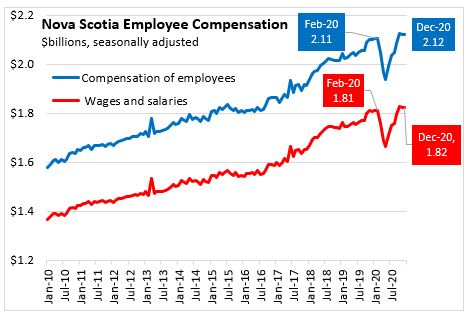
Monthly employee compensation was above February 2020 pre-COVID levels for October, November and December. As of December employee compensation is 0.8% higher than February 2020, with wages and salaries up 0.8% and employer’s social contributions up 0.9%.
Compared to December 2019, employee compensation increased 1.0, with wages and salaries up 0.9% and employer’s social contributions up 1.4%.

In the fourth quarter of 2020, Canada’s employee compensation was up 2.5% from the previous quarter with all provinces registering gains. British Columbia (+4.1%), Prince Edward Island (+3.7%) and Nova Scotia and New Brunswick (both +3.3%) reported the largest increases in the fourth quarter. The smallest percentage increases were in Alberta (+1.6%) and Quebec (+1.7%).
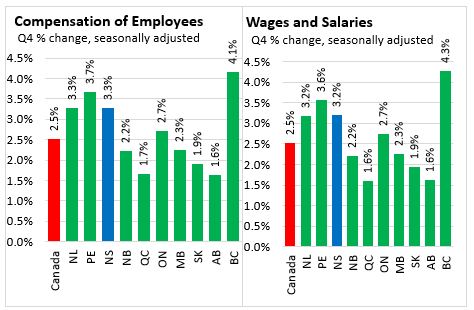
Canada's employee compensation in 2020 declined 1.6% compared to 2019. The largest percentage declines were reported in Alberta (-6.0%) and Newfoundland and Labrador (-4.1%). In 2020, three provinces reported increases: Prince Edward Island (+1.9%), New Brunswick (+0.7%) and Quebec (+0.2%). Nova Scotia compensation of employees in 2020 was essentially unchanged (0.0%) compared to 2019.
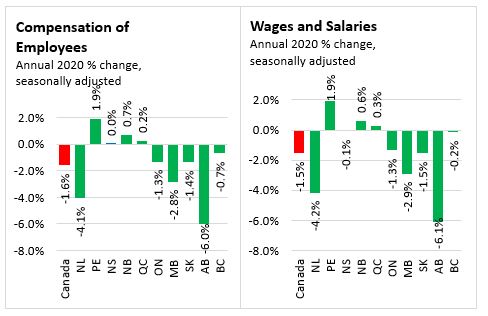
With gradual reopening of economies in May, employee compensation started showing signs of recovery in June 2020. Compared with May 2020, employee compensation was up 3.1% nationally, with the largest gains in Quebec (+5.3%) and New Brunswick (+4.9%). The smallest percentage gain was in Manitoba (+0.6%).
Employee compensation continued its upward trend in July in all provinces. Nationally, employee compensation increased 4.0% in July with Quebec (+5.6%) leading the way. The smallest percentage gain was recorded in Saskatchewan (+0.5%).
The pace of growth somewhat slowed in August with all provinces registering gains except for Prince Edward Island and New Brunswick. Employee compensation increased 1.6% nationally with Saskatchewan (+4.8%) and Alberta (+2.4%) posting the largest percentage gains in August.
In September, all provinces saw month-over-month growth in compensation with the national total increasing 2.1%. The largest percentage gains were recorded in Prince Edward Island (+3.9%) and New Brunswick (+3.2%).
Compensation growth slowed in October to a 0.7% pace nationally with the fastest increase in Prince Edwards Island and Nova Scotia (both +2.0%) but decline in Saskatchewan (-0.1%) and Alberta (-0.3%).
National compensation of employees declined in November with a 0.2% month-to-month change. All provinces except Ontario, Alberta and British Columbia reported declines. The largest declines were in Quebec (-1.9%) and Prince Edward Island (-1.7%). Growth continued to be slow in December with a 0.3% increase for Canada.
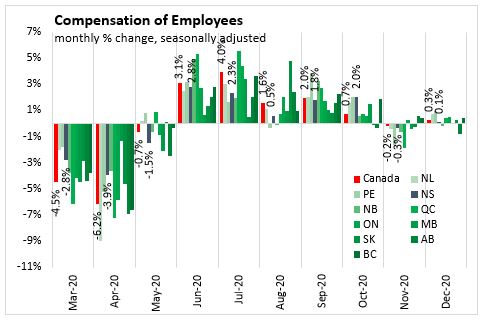
Comparing the seasonally unadjusted data for Q4 2020 with the same quarter in 2019, total wages and salaries increase 1.8% in Nova Scotia. The largest increase in finance and real estate (+10.0%), transportation and storage (+8.6%), and construction (+7.2%). Wages and salaries largest percentage declines were in information and culture (-11.0%), agriculture, forestry, and fishing (-7.2%), and mining, oil and gas extraction (-4.7%).

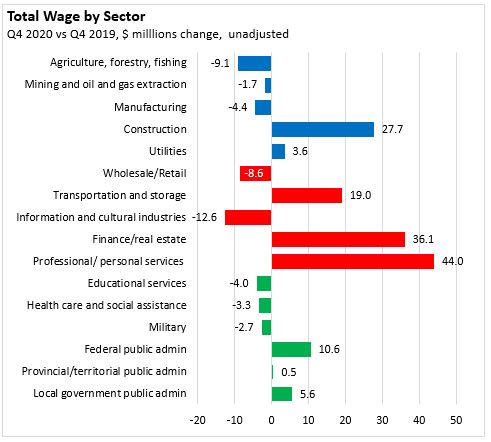
Total wages and salaries in Nova Scotia (seasonally unadjusted) declined 0.1% or $18.4 million from $21.240 billion in 2019 to $21.221 billion in 2020 . In terms of dollar changes, the wholesale and retail trade sector reported the largest decline (-$162.1 million), followed by manufacturing (-$65.3 million) and agriculture, forestry, and fishing (-$39.9 million). Military and provincial public administration also reported declines. Increases in compensation of employees occurred in all other sectors with the largest dollars increases in Finance and real estate (+$66.7 million), health care and social assistance (+$36.6 million) professional and personal services (+$36.5 million) and transportation and storage (+$35.7 million).
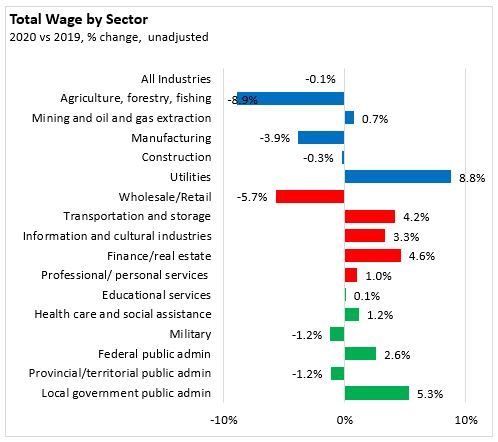

Note: comparison of wages and salaries by sector rely on data that are neither seasonally adjusted nor adjusted to reflect differences in pay periods from one year to the next. Compensation of employees data includes wage and salaries income that is supported by government subsidy programs including COVID measures such as the Canadian Emergency Wage Subsidy.
Statistics Canada. Table 36-10-0205-01 Wages, salaries and employers' social contributions (x 1,000)
<--- Return to Archive